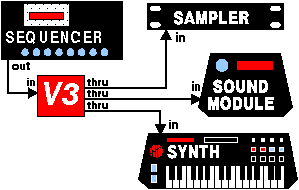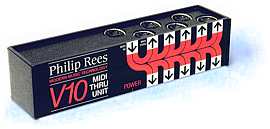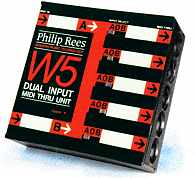
 | ||||||
 |
|
Interconnecting several items of MIDI gear can be a frustrating business. A Midi Thru box can often help.
Some of your MIDI gadgets may lack the MIDI Thru (MIDI-thru) sockets which are required for connecting several devices together in a 'chain'. Where MIDI thru ports are provided, the signal throughput may introduce 'duty cycle' distortion or time delays - so 'chain' performance may be unacceptable, particularly on 'chains' of three or more.
![[Diag: comparison of "Chain" and "Star" MIDI networks]](pix/thrnetht.gif)
The preferred alternative to the troublesome 'chain' is the 'star' network. The only snag is that for a 'star' network you will need more than the single MIDI Out, which is all that may be available on your master controller. You'll need a MIDI thru box to solve this problem by setting up a MIDI 'star' system.
A MIDI network may be expanded via a hybrid combination of thru box 'star', and chained thrus.
The superb Philip Rees range of MIDI thru boxes (splitters) consists of the battery-powered V3 MIDI splitter, the line-powered V4 MIDI splitter, the externally-powered two-bank V8 MIDI splitter, the mains-powered V10 MIDI splitter and the mains-powered dual-input W5 MIDI splitter.
Philip Rees pioneered very low cost thru boxes, and we have been at the forefront of MIDI splitter design since 1987. Our range of thru boxes gives the widest choice of power supply options and MIDI thru configurations in the world.
 V3 MIDI Thru Unit
V3 MIDI Thru Unit The highly successful V3 is a handy one into three MIDI thru unit, which you can use to convert one MIDI out into three buffered parallel outs. The V3 MIDI Thru Unit is very compact - just 58mm x 69mm x 23mm.
The highly successful V3 is a handy one into three MIDI thru unit, which you can use to convert one MIDI out into three buffered parallel outs. The V3 MIDI Thru Unit is very compact - just 58mm x 69mm x 23mm.
In the example diagram, the sequencer is the MIDI master device. MIDI commands from its MIDI Out port must arrive at the MIDI In ports of all three slave devices (sampler, sound module and synth). The V3 MIDI thru box generates three 'thru' copies of the signal arriving at its input, each capable of driving one of the slave devices.
![[Photo: V3 MIDI through unit]](pix/v3photo.jpg) Power options
Power optionsYou can use a PP3 (6F22) 9V battery to power your V3 MIDI Thru Unit- the battery will give a very long life (usually a year or more in normal use. When you leave the IN socket unconnected, or your MIDI master device is quiescent or switched off, no battery power is consumed.
You can use and external 6Vdc to 9Vdc supply to power your V3 - you'll have to make connection via a PP3 type snap (press stud) connector with the negative voltage on the male stud. The current demand is just 10mA maximum.
You simply slide out the top side panel to fit the battery or the connection from the battery eliminator.
 V4 MIDI Thru Unit
V4 MIDI Thru Unit![[Photo: V4 midi splitter]](pix/v4photo.jpg) The new V4 is a handy one-into four MIDI Thru unit, which you can use to convert one conventional MIDI Out (connected to the IN socket of the V4) into four cleverly buffered parallel Outs (available at the THRU sockets of the V4).
The new V4 is a handy one-into four MIDI Thru unit, which you can use to convert one conventional MIDI Out (connected to the IN socket of the V4) into four cleverly buffered parallel Outs (available at the THRU sockets of the V4).
You will find that the V4 MIDI Thru Unit is a convenient pocket-sized gadget. Its dimensions are just 58mm x 69mm x 23mm.
The power for the V4 buffer circuit is derived from the MIDI connections at its MIDI In socket. This circuit configuration inevitably makes certain assumptions about the master MIDI device: it assumes that the screen connection on pin 2 is the zero volts of the associated MIDI driver circuit; it assumes that the source connection on pin four is derived from a five volt power supply; it assumes that the MIDI driver current switch is connected via pin 5. As the design of the MIDI master device could fail (for good reasons) to meet any of these criteria, compatibility problems can occur with any line-powered MIDI gadgets; problems are however rare.
It may seem counter-intuitive to have what is effectively an amplifier powered from its own input signal! Please be assured that, with suitable circuit design, sufficient power can indeed be derived from the MIDI master device.
![[Diag: Using V4 MIDI splitter (1)]](pix/v4app1.gif)
The MIDI In and power control circuit of the V4 MIDI Thru Unit is designed for best possible compatibility and resistance to damage. It will work perfectly with the vast majority of MIDI master devices. When an incompatible driver is found, it is nearly always easy to rearrange the system to avoid the problem: in the example below the MIDI Thru of the Synth Expander is chosen to drive the V4 instead of the incompatible MIDI output of Synth 1.
![[Diag: Using V4 MIDI thru box (2)]](pix/v4app2.gif)
 V8 MIDI Thru Unit
V8 MIDI Thru Unit![[Photo: V8 midi thru box]](pix/v8photo.jpg) Two output banks
Two output banksThis MIDI Thru box has eight Thru outputs. They are arranged as two banks of four. The sockets for one output bank are on the left hand side of the box. The sockets for the other output bank are on the right hand side.
The V8 has two MIDI input ports, marked 'A' and 'B'. The socket for input A is on the left of the box, and that for input B is on the right.
There is an INPUT SELECT slide switch for each of the output banks.
Each switch has three positions. In the position marked 'A', the MIDI signal received at MIDI IN A is routed to the relevant bank of four Thru outputs. In the position marked '0', no MIDI signal is routed to the corresponding bank of outputs. In the position marked 'B', the MIDI signal received at input B is routed to the relevant output bank.
![[Diag: V8 MIDI THRU unit application]](pix/v8app.gif)
It is, of course, possible to have all eight MIDI outputs of the V8 MIDI Thru Unit driven from the same input signal — that is, you may select input A (or B) for both output banks.
There are two flashing lamps that indicate when MIDI data is being received at each of the MIDI inputs. The lamp signal is pulse stretched so that even sparse MIDI data is readily perceived. A POWER lamp is also provided, which indicates when the V8 MIDI Thru Unit is connected to a suitable DC power supply.
The V8 MIDI Thru Unit does not incorporate its own power supply, so it requires to be connected to an external DC power source. An ordinary mains (ac power) adaptor (regulated or unregulated) of between nine and twelve volts will do fine. The current requirement is just 30mA. In the UK and Eire, a mains (ac power) adaptor is supplied with the unit.
Power connection is made via a 3.5mm jack socket, with the tip positive. The DC power is regulated within the V8. Protection against reverse connection is incorporated.
The dimensions of the V8 MIDI Thru Unit are 109mm x 109mm x 40mm.
 V10 MIDI Thru Unit
V10 MIDI Thru Unit The V10 is a one-into-ten MIDI thru box, which will convert one MIDI out into ten buffered parallel outs. It will provide your MIDI master device with thru outputs to drive up to ten slave devices in a 'star' network.
The V10 is a one-into-ten MIDI thru box, which will convert one MIDI out into ten buffered parallel outs. It will provide your MIDI master device with thru outputs to drive up to ten slave devices in a 'star' network.
The special Philip Rees MIDI-Thru system provides effective power isolation without the use of optocouplers. This ensures consistent high-speed performance.
![[V10 block diagram]](pix/v10diag.gif) Mains-powered
Mains-poweredThe mains (ac power) supply of the V10 MIDI Thru Unit is built-in, so no external adaptor is required. The mains lead (ac power cord) is permanently fitted, so it won't get lost. It is supplied with a mains (ac) plug fitted. Versions are available for 110 V ac or 230 V ac supplies.
There is a POWER indicator lamp. The shape of the V10 is funky and the dimensions are surprisingly compact - 175mm x 40mm x 45mm.
 W5 Dual Input MIDI Thru Unit
W5 Dual Input MIDI Thru Unit![[W5 midi thru box block diagram]](pix/w5block.gif) The W5 has five MIDI thru outputs, and two MIDI inputs - with independent source selection for each output.
The W5 has five MIDI thru outputs, and two MIDI inputs - with independent source selection for each output.
On one side of the W5 are the two input sockets, and on the other side are the five thru outputs. On the front panel are the five three-position slider selectors, one for each output. Each switch can independently link the corresponding output to either of the inputs or a centre 'off' position. The centre 'off' position puts the appropriate MIDI thru output into a mute state.
 Robust enclosure
Robust enclosureThe case of the W5 MIDI Thru Unit is 109mm x 109mm x 40mm. The integral mains lead (ac power cord) comes with a plug. An LED indicator shows when the device is under POWER. Space is provided on the hardy polyester front panel to name the input and output connections; a permanent ‘overhead projector’ pen is a suitable marker.
As with all our ac-powered products, versions are available for 110 V ac as well as 230 V ac. Plugs for various international standards are also available.
![]() You may need to download the Acrobat Reader free from the Adobe site in order to view or print .pdf documents.
You may need to download the Acrobat Reader free from the Adobe site in order to view or print .pdf documents.![]() The information on this thru unit page is also available as an Acrobat .pdf
file - size: 304K bytes.
The information on this thru unit page is also available as an Acrobat .pdf
file - size: 304K bytes.

![]() to Phil Rees Music Tech home page
to Phil Rees Music Tech home page
![]() to Phil Rees Music Computers division index page
to Phil Rees Music Computers division index page
![]() to Phil Rees MIDI division index page
to Phil Rees MIDI division index page